The next-gen MacBook Pro with Retina Display Review
by Anand Lal Shimpi on June 23, 2012 4:14 AM EST- Posted in
- Mac
- Apple
- MacBook Pro
- Laptops
- Notebooks
Last year when I wrote about the new MacBook Airs I offered two forward looking paragraphs:
What happens from here on out is what's really interesting. Intel has already committed to moving the TDP of its mainstream parts from 35W - 45W down to 10 - 20W. Since the Air is the new mainstream Mac notebook, Apple has already made that move. The performance in this 10 - 20W segment is going to get much better over the next two years, particularly once Haswell arrives.
The Thunderbolt Display is the first sign of what's to come. Moving IO controllers and expansion into the display, and potentially even moving discrete GPUs out of the notebook are all in store for us. Apple is really ahead of the curve here, but it's easy to imagine a future where laptops become a lot more like the new Air and shift to a couple high bandwidth ports instead of numerous lower bandwidth connections.
Perhaps I was being too aggressive in the prediction of a couple of high bandwidth ports. After all, the next-generation MacBook Pro with Retina Display features four such IO ports (2 x Thunderbolt and 2 x USB 3.0). But you get my point. Gigabit Ethernet and Firewire 800 are both gone. The discrete GPU is still present but I suspect even its days are numbered, at least inside the chassis. The personal computer as we knew it for so long, is changing.
The personal computer is getting thinner, lighter, more integrated and more appliance-like. The movement is no longer confined to just Apple either. The traditional PC OEMs are following suit. Even Microsoft has finally entered the PC hardware business, something it threatened to do for years but hadn't until now. Distribution models will change, the lines between different form factors will continue to blur. What was once a mature industry is going through a significant transformation. It’s exciting but at the same time it makes me uneasy. When I first got into this industry everyone had stories of companies with great ideas that just didn’t make it. As we go through this revolution in computing I’m beginning to see, first hand, the very same.
Apple makes the bulk of its revenue from devices that don’t look like traditional personal computers. For the past couple of years I’ve been worried that it would wake up and decide the traditional Mac is a burden, and it should instead be in the business of strictly selling consumer devices. With its announcements two weeks ago in San Francisco, I can happily say that my fears haven’t come true. At least not yet.
It’s been a while since Apple did a really exciting MacBook Pro launch. Much to my surprise, even the move to Sandy Bridge, the first quad-core in a MacBook Pro, was done without even whispers of a press conference. Apple threw up the new products on its online store, shipped inventory to its retail outlets, updated the website and called it a day. Every iPhone and iPad announcement however was accompanied with much fanfare. The MacBook Pro seemed almost forgotten.
With its WWDC unveil however Apple took something that it had resigned to unexciting, dare I say uncool status, and made a huge deal about it. Two weeks ago Apple did the expected and offered relatively modest upgrades to all of its portable Macs, all while introducing something bold.
Apple calls it the MacBook Pro with Retina Display. You’ll see me refer to it as the next-gen MacBook Pro, Retina MacBook Pro, rMBP or some other permutation of these words.
After using it for the past two weeks I can honestly say it’s the best Mac Apple has ever built. And there’s a lot more to it than hardware.
Portability
If you were hoping for a 15-inch MacBook Air, that’s not what the rMBP is. Instead it is a far more portable 15-inch MacBook Pro. I have to admit I was a bit let down the first time I laid eyes on the next-gen MacBook Pro, it looks good but it doesn’t look all that different. The disappointment quickly faded as I actually picked up the machine and started carrying it around. It’s not ultra light, but man does it make the previous chassis feel dated.
While I never really liked lugging around the old MBP (and it always made me feel like the old fogey at tradeshows where everyone else had something 13-inches or smaller), carrying the rMBP is a pleasure by comparison. Pictures really don’t do it justice. The impressively thin display assembly or overall chassis thickness look neat in a photo but it’s not until you actually live with the rMBP that you can appreciate what Apple has done here. I carry around a 15-inch MacBook Pro because it’s my desktop, and as such it’s incredibly useful to have with me when I travel. For my personal usage model, the Retina MacBook Pro is perfect.
If your workload demands that you need the performance of a MacBook Pro and your lifestyle requires you to carry it around a lot, the reduction in thickness and weight alone will be worth the upgrade to the rMBP. If you spend most of your time stationary however, you’ll have to be sold on the display and internal characteristics alone. The bad news is if the design doesn’t get you, everything else will.

From left to right: 11-inch MacBook Air, 13-inch MacBook Air, 15-inch MacBook Pro, MacBook Pro with Retina Display
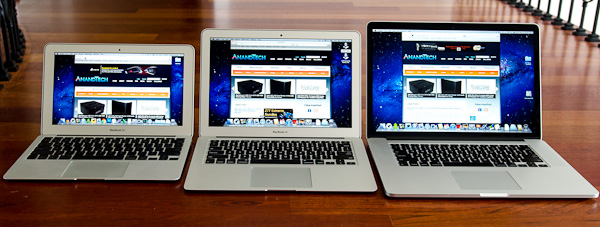
From left to right: 11-inch MacBook Air, 13-inch MacBook Air, MacBook Pro with Retina Display
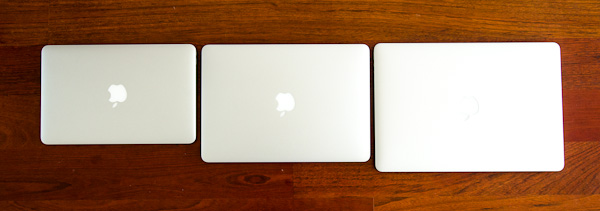
From left to right: 11-inch MacBook Air, 13-inch MacBook Air, MacBook Pro with Retina Display


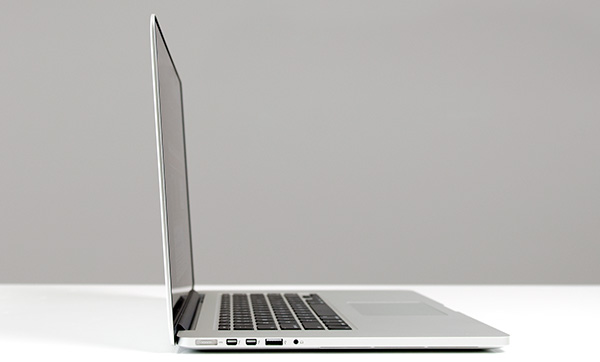
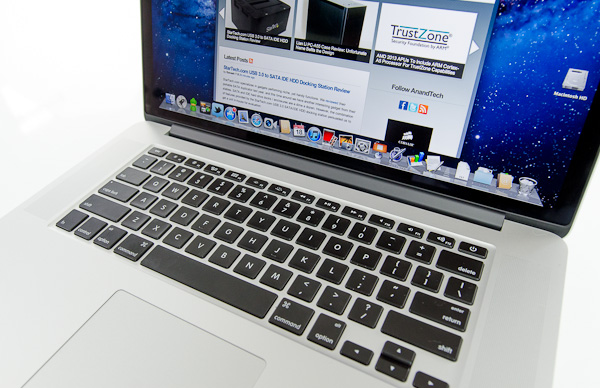
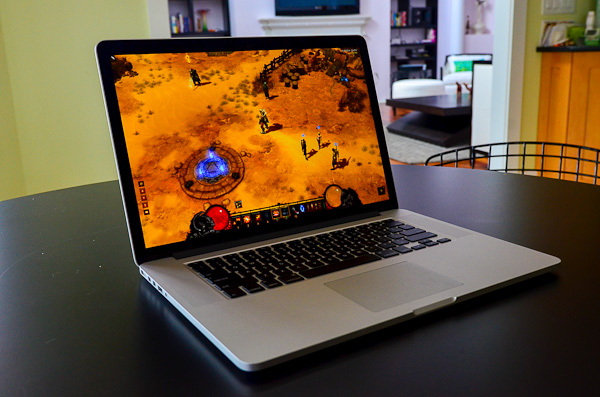
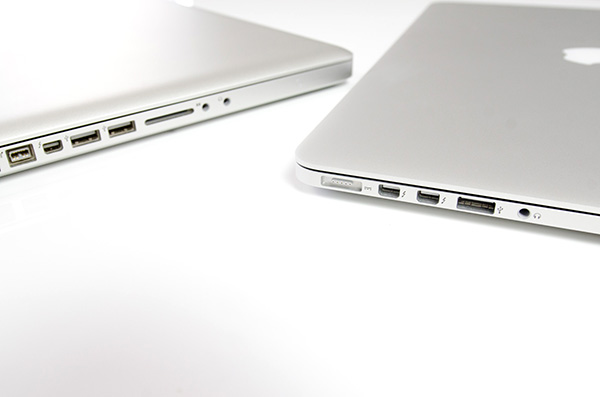
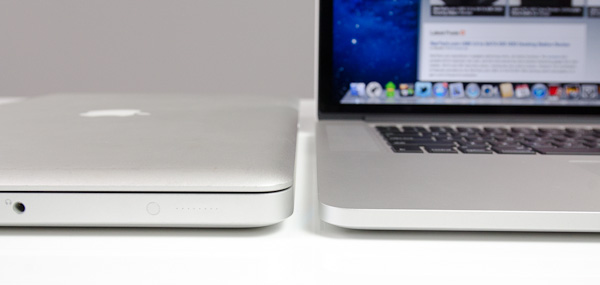








471 Comments
View All Comments
Kill16by9TN - Sunday, June 24, 2012 - link
What I don't understand, how does it make any sense, to use scaling factors resulting in 16:9 (TV/movie) resolutions (2560x1440, 2048x1152, 1600x900) on a 16:10 computer panel with native 2880 x 1800, or scaled down, 1440 x 900 pixels.ImSpartacus - Sunday, June 24, 2012 - link
They aren't. In OSX, you can have 1440x900, 1680x1050 or 1920x1200. Those are all 16:10.Kill16by9TN - Sunday, June 24, 2012 - link
Sorry, looks like my bad. I was so baffled by those 16:9 resolutions in the settings window screen shot, that I completely missed that window's "Thunderbolt Display" title and the monitor icon on the left.So apparently Anand was using a an external 16:9 monitor for this test and everything is fine again ;-).
yottabit - Sunday, June 24, 2012 - link
I just want to take a moment to say thanks for always sticking to the philosophy of not releasing a review until it's ready. Even though other reviews of the Retina display MBP have been up for a while I honestly didn't even read them because I love waiting for what Anand is going to come up with. I still count on Anandtech as my "one-stop-shop" for reviews and I've got to say it does not disappoint.I know people are complaining about the lack of upgrade potential on the retina Mac Book Pro, but I think it's Apple's right. Think about it- they now have a product that is truly unrivaled in any category. Until some other competitors can put pressure on them, I don't think we'll see upgradeability come back into play.
Apple has done something really tremendous here with their retina display panel, I think this is the longest head start they will have ever had on anyone since the iPod. With all the proprietary graphics drivers/GPU scaling, and the development of this custom display at this pricepoint, I really think it will be years before we see a PC with a similar overall package. So long as Apple can maintain exclusivity with it's suppliers (and that's never been a problem in the past)
This display isn't something somebody can just knock off, it's an engineering marvel IMO. And it's going to be hard for any other OEM to justify the volume to market a display like this.
Reading about Apple's influencing Intel to speed up iGFX development sent chills down my spine. I can't believe how much Apple has grown.
I've got to say I think Steve Jobs would be really proud of the launch of this device. I don't think many people realize how big this is going to be!
shushamen - Sunday, June 24, 2012 - link
Anybody knows how the Xcode iOS simulator handle the retina display , I meant what happened when you selected iPad retina, does it scale it or use a pixel to pixel.Currently I am using an imac 27 for iPad dev and even at 2560 x 1440 I have to scroll inside the iOS simulator when target iPad retina ( I know I can use the sim scale option ), I am hoping that with this new MBRD I can solve the issue.
Baked - Sunday, June 24, 2012 - link
How many times do you the cleaning lady come over to dust your mansion? Or do you have live in crew? I'm guessing the latter.Must be nice being so filthy rich.
dtolios - Sunday, June 24, 2012 - link
People talk about "creative laptops" vs. consumer laptops, innovation etc...Apple has been pushing things around for a long time - and failed BIG in the process. And no, not because it was innovative, but because of proprietary stubbornness: be different at all costs. It's not about "creative users"...it's about "wannabees", and that's what 95% or more (guesstimation) of all the MBPs out there are and will be used for. Showing off while browsing FB and tweeting (instead of being creative) in schools and cafes.
The rMBP is a good start for something great, no doubt, and I am happy that all these vanity addicts will fund more and more of the good stuff to grow and mature (cause obviously the screen scaling application has to work a long way to reach enough potential to be used in creative stuff).
Till then, I hope the rMBPs with all the proprietary hardware connections/integration won't make a lot of proud buyers to cry with increased reliability issues and zero user-end customization/repair/replace support ( you know, MBPs have been far from the best in this field already, and it looks it will get lost)...I will be waiting for a year or so to hear what Apple service will ask for a blown MoBo.
robco - Sunday, June 24, 2012 - link
Huh?Apple's sales have outpaced the industry for some time now. Their sales of notebooks has gone up considerably. The MacBook Air is becoming quite popular. If that's failing big, most companies would love to fail that much.
The standard 2.5" form factor wouldn't fit inside an Air or the new rMBP. So Apple had to do their own thing. That's not Apple's fault. The same is true with SO-DIMMs. As for reliability and service, Apple tends to get top marks there too. I have taken my current 2009 MBP in twice. Once to fix a sticky trackpad that wouldn't click, and once to replace the battery. Both times the machine was fixed, under warranty, quickly. I made an appointment, dropped by the Apple Store and they took care of it. Easy.
Apple is not stupid. They've been making the new Air for some time now. If they were constantly replacing blown mobos and components were failing all the time, they wouldn't still be making them. I know quite a few MacBook users and they all have found them to be durable, reliable machines. Most people will likely move to the new Air because they don't need the CPU and GPU power of the new rMBP.
spronkey - Sunday, June 24, 2012 - link
Listen to what you're saying.#1 They designed a machine ignoring existing standards. It's not like they *couldn't* have made a very, very similar machine that used standardised parts. They just chose not to.
#2. SODIMMs? What about pitching a new standard, then? Or how about adding 1mm. Noone would have noticed, and then in two generations they can thin it out even more.
#3. Warranty. Perhaps in the US Apple are good with service. Over here in New Zealand they don't exist - we get Authorised Apple Service Providers, who try their absolute hardest to weasel out of fixing anything, and whose first mandate is to never admit design faults like those that exist with the original MagSafe connectors!
#4. What happens when the machine drops out of warranty? Let's not forget that Apple's 1 year standard warranty isn't exactly generous. Oh wait - Apple want to gouge you some more by offering AppleCare. But it's not just an extended warranty, it comes with all this other crap you don't want, like phone support. And it's four times the price of a retail store's extended warranty.
How about they put their money where their mouth is and start backing up their "superior" devices with superior warranties. Oh, and while they're at it, they can stop price gouging other countries by picking ridiculously low exchange rates to use...
robco - Sunday, June 24, 2012 - link
They do make a similar machine using standardized parts, they still sell the non-retina MBP. It has a standard 2.5" drive bay and SO-DIMMs. It also is larger and heavier. They wanted to slim down the machine and cut down on weight, these were the design trade-offs they had to make.As for warranty, AppleCare costs $50USD more than Dell's three-year warranty upgrade for an XPS 15, expensive but not out of line. For major defects that happen out of warranty, it depends. Apple has made repairs and replacements in the past with battery issues and faulty GPUs.
As for international support, outside major European and Asian countries, it is pretty crappy. It's going to take some effort on Apple's part to improve that. Also bear in mind that we don't have a 15% GST in the US. Our sales taxes vary from state-to-state (some don't have one), so it's not included in the retail price. Here in CA, the price jumps from $2199USD to $2393.92 with $186.92 in sales tax. Not as expensive as the 15% GST in NZ.